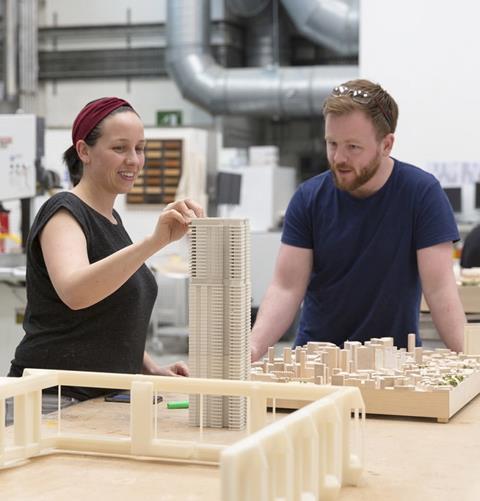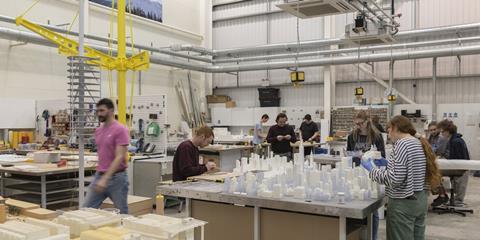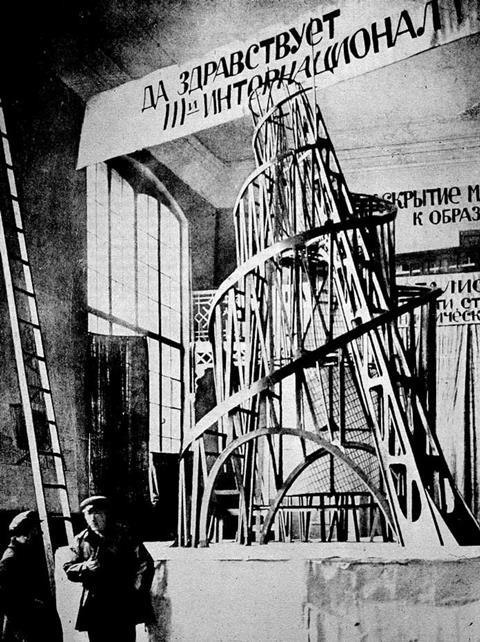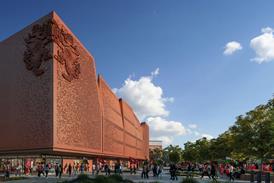Apprentices will be exempt from tuition fees, a feature that is hoped will make the programme accessible to a broader range of candidates

Foster + Partners is helping to lead a new initiative to create the UK’s first Model Maker Apprenticeship Standard.
The development of the new apprenticeship standard is part of a collaborative effort involving a wide range of employers in the creative industries, universities, and the Institute for Apprenticeships and Technical Education (IfATE). Organisations backing the scheme include AHMM, Heatherwick Studios, Make, RSHP, University of Bath, English National Opera and the Royal Opera House.
The programme, which received official approval in July 2023, represents a step towards formalising the training route for model makers within the architectural sector and related creative fields.
The newly established apprenticeship is a Level 6 qualification, equivalent to a bachelor’s degree, and spans three years. It provides a blend of workplace learning and academic training, with apprentices gaining practical experience in a professional environment while also benefiting from the educational resources of an associated university.
Peter Garstecki, Education Manager at Foster + Partners and Chair of the Trailblazer Group, said: “Apprenticeships are essential for us to grow and diversify talent. Since launching our Architecture Apprenticeship Standards six years ago, we have witnessed the immensely positive impact of the programme first-hand and expanded the range of apprenticeships we offer.
“Developing the new Modelmaking Apprenticeship was the natural next step, allowing candidates to learn the skills they need to succeed within this specialist industry.”

Apprentices will be exempt from tuition fees, a feature that is hoped will make the programme accessible to a broader range of candidates. In addition to receiving a salary, apprentices are entitled to the standard benefits associated with employment.
Diane Teague, Assistant Head of Modelmaking at Foster + Partners and Co-Chair of the Trailblazer Group, said: “Modelmaking is a natural fit for an apprenticeship programme, due to the highly collaborative and practical nature of the work.
“We are delighted to be opening our doors to those who are passionate about developing a career in modelmaking and want to learn in a fast-paced, hands-on environment.”
The introduction of the Model Maker Apprenticeship is aimed at strengthening the ties between industry and academia, seeking to ensure that the training provided is both relevant and aligned with the needs of employers. It is also hoped that by fostering connections between employers and educational institutions, the programme will help contribute to the diversification of the profession, opening doors for individuals from a variety of backgrounds who may not have otherwise considered a career in modelmaking.
>> Also watch: The Loneliness of A Late-Night Model Maker
Claire Holman, Senior Lecturer of Modelmaking at Arts University Bournemouth, said: “Professional model makers possess unique and specialised knowledge and skills, which align perfectly with the apprenticeship ethos of working and learning concurrently. The contribution of apprenticeships to the modelmaking workforce will enhance and broaden the industry’s pool of talented makers.”

Modelmaking has long been a critical component of architectural practice, widely seen as a central way to explore and communicate design concepts. However, the traditional pathways into this craft have often been informal. It is anticipated that once universities have developed courses based on the approved Standard, any company in the country will be able to employ a Model Maker Apprentice.
Jeff Powers, senior associate, head of making, Heatherwick Studio, said: “At Heatherwick Studio, we are excited by the announcement of the Model Making Apprenticeship Programme, a new initiative aimed at nurturing the next wave of design and architectural talent. We believe that hands-on making is at the heart of design. This apprenticeship programme gives students the chance to dive into the art of modelmaking and gain an entry point into the world of design.”
Model making from ancient Egypt to the modern day
Architectural model making has a rich history, serving as a crucial tool for visualising and communicating design ideas. Originating in ancient civilisations like Egypt and Greece, where models were used to plan monumental structures, the practice evolved significantly over time. During the Renaissance, architects like Leonardo da Vinci and Michelangelo employed models to explore complex geometries.

Many of the most famous architectural models, such as Vladimir Tatlin’s proposal for a Monument to the Third International are perhaps best known because they represent unbuilt works.
A pivotal moment in the history of architectural model making occurred in the 17th century with Sir Christopher Wren’s Great Model for an unrealised Greek Cross design for St. Paul’s Cathedral. This scheme was approved by King Charles II on 16 December 1672, leading to the creation of a wooden model so large ‘that a Man might stand within it, the better to consider all the proportions of the same as well within as without’. The model, nearly 13 feet long and 10 feet high, represented Wren’s initial design in intricate detail and played a critical role in securing approval for the project, although the final, revised scheme, demanded by the cathedral’s commissioners was ultimately more conventional in its plan.
Wren’s Great Model influenced architectural practices by emphasising the importance of physical models in both the design process and in gaining patron support. It underscored the model’s role not just as a technical tool, but as a persuasive instrument in architectural communication, a practice that continues in modern architecture.
In the 20th century, Antoni Gaudí’s models for the Sagrada Família in Barcelona became another iconic example. Gaudí used elaborate plaster models to explore the church’s complex, organic forms. Tragically, these models were smashed by anarchists. However, devoted followers painstakingly pieced the fragments back together, and these reconstructed models have formed the basis for the ongoing construction of the Sagrada Família, demonstrating the enduring importance of models in architectural legacy and innovation.
>> Also read: Confessions of an architectural modelmaker
Trailblazer Group
• 3DD
• Allford Hall Monaghan Morris (AHMM)
• Amalgam Models
• English National Opera
• EPH Creative
• Foster + Partners (chair)
• Heatherwick Studios
• LL&Co
• MAKE Architects
• Modelu (Bristol modelmaker craft)
• Ogle Models
• Pipers Model Makers
• Post21 Ltd
• Royal Opera House
• RSHP Architects
Participating universities
• Arts University Bournemouth
• University of Bath
• University of the Creative Arts
• University of Hertfordshire


















No comments yet